Gloom was the predominant mood on the sunny day this aut-umn when Medecins Sans Frontieres (MSF) explained to Delhi journalists how it lost a long legal battle with Pfizer over the pneumococcal conjugate vaccine, or PCV. The US pharma major had been granted a patent for Prevnar 13, said Leena Menghaney, South Asia head of MSF’s Access Campaign. That meant a 68 per cent rise in the cost of the vacc-ine available to developing countries.
The Red In That Green
Once known for strong patent laws, India is now yielding to pharma MNCs

The Indian patent authorities’ decision means each dose of the vaccine available to parents will cost Rs 3,800. Moreover, the spike in cost of procurement disables even the government to make the PCV available under the Universal Immuni-sation Programme.
Pfizer’s claim on the patent in India was based on assembling together serotypes (or different strains) of streptococcus pneumonia into a single carrier. The 1849-founded company already held the patent for a 7-valent PCV which also, acc-ording to MSF, an international huma-ni-tarian NGO, denoted a mere addition of serotypes to a vaccine available in the public domain. Simply put, Pfizer found a way to add more ingredients to an already available essential mix. This, critics say, is part of a bid to ‘evergreen’ the patent, or maintain monopoly and control prices.
New York-headquartered Pfizer fiercely defends its right to monetise the fruits of its research. Its press statement in respo-nse to Geneva-based MSF’s allegations of evergreening said: “Supported by extensive clinical research and real-world exp-erience, each dose of PCV13 requires 400 different raw materials, 580 manufacturing steps, 678 quality tests and two and a half years to produce.” It claimed keenness in further enhancing access to this vaccine in India, “both in the market as well as through partnership with the government”. The vaccine is available at a discounted rate for the Indian government, Pfizer says, through GAVI—the global public-private vaccine alliance. The GAVI commitment covers only a five-year period, after which the governm-ent will have to pay over $10 for each dose.
The decision on PCV13, to many, reflects a new state of affairs. India’s patent laws, touted to be one of the strongest until a few decades ago, have now succumbed to pressures from developed countries, and in turn foreign MNCs with vested interests. The short-term effect it has is on health costs for the average Indian. In the long run, it keeps prices high by creating an environment that does not encourage indigenous invention and R&D.
The agreement on Trade Related Aspects on Intellectual Property Rights (TRIPS), followed globally for laws on patent rights, was implemented in India in 2005 by amending the Indian Patent Act of 1970. Section 3(d) of the present law says “new forms of old substances cannot be patented unless they differ significantly in properties with regard to efficacy”. This should be a vital bulwark against evergreening, yet it hasn’t been so.
The first celebrated case after TRIPS was when Novartis applied at the Chennai patent office for drug Glivec in 1998, a slightly different version of its anti-leukaemia drug for which it had a 1993 patent. When the patent officials rejected the application, the Swiss multinational petitioned the courts to declare Section 3(d) non-compliant to the TRIPS agreement. Taken up after India settled its patent regime by 2005, a seven-year-legal battle ensued. The Supreme Court finally rejec-ted the petition, ruling in favour of public availability and access.
This was a standalone case, according to T.C. James, former director (IPR) in the commerce ministry’s department of ind-ustrial policy and promotion (DIPP). “Since then a long list of patents has been allowed with minor modifications and no change in efficacy,” he says. Since that 2013 judgement, the US and UK have tried to get Indian laws diluted. “MNCs perceived a threat from the steady growth of Indian pharma companies before 2005,” says James. “So, several attempts were made to tweak laws in their favour.”
The US even had India put on the “prio-rity watchlist” of its trade representative’s Special 301 report, which lists barriers to American business. “Being put on the watchlist could mean loss of trade benefits. This was a pressurising tactic by the US, which wanted laws to be changed in their favour,” says K.M. Gopakumar of Third World Network. A high-level India-US working group set up in 2014 has since managed to tweak Indian patent laws every year, he adds.
“The influence of MNCs is such that, last year, a training camp for Indian patent officers was organised by the India-US joint business council. This council’s members are mostly big pharma MNCs. So patent officers were being trained by pharma majors on patent laws!” he says. A DIPP official admits countries like the US and UK do use pressure tactics on behalf of their commercial lobbies, but India usually does not succumb to them. “Our laws on patents are very strong,” she says, but avoids comment on the Pfizer case.
A month ago, the USTR again used the threat of putting India on the watchlist in the wake of medical devices being brought under a price cap in the past year. This was spearheaded through a letter by a collective of medical device manufacturers, AdvaMed, who lobbied the USTR in a letter to revoke India’s trade sanctions.
An IPR policy for a country like India should seek to balance health rights with the need to protect assets. Yet, since 2005, patent laws have been seen less from a public interest perspective. Says Dr A. Damodaran, an expert on IPR: “The patent law was revised in a hurry in 2005, making it friendlier towards multinationals as compared to Indian companies.”
?This is clear in the lack of compulsory licences that bedevils Indian generic manufacturers—such a licence would allow them to produce a patented drug or vaccine without taking the patent-holder’s permission. Several countries use compulsory licence as a tool to provide affordable healthcare, but Indian patent offices have issued it only once.
Dinesh Abrol, convenor of the nati-onal working group on patent laws, suggests this is because the current disposition believes granting of such licences will dissuade FDI in pharma. “The government believes stronger patent laws would attract more FDI even though there is no evidence to show that,” he says. The DIPP official, though, says, “There’s a fixed procedure for compulsory licensing. There is no resistance by the government to granting such licences.”
Abrol’s studies suggest stronger patent laws (favouring MNCs) actually dissuade investment within India. “What is requi-red for pulling in FDI is better infrastructure and manufacturing hubs, not strong patents,” he says. The situation, he says, is so bad the committee for compulsory lic-ensing doesn’t even meet. “The provis-ion is on the statute, but not implementing it seems to be the government’s way of being prudent,” he says.
Companies and organisations can app-eal to the courts under the present law before or after the grant of a patent, but the provision is often not used since such appeals take eight to ten years to resolve. “In the meantime, no one has access to the technology or even the current drugs in the market,” explains Menghaney. So even in the Pfizer case, MSF chose to seek a review by the patent office.
The changing laws have done no favours to Indian manufacturers. According to a paper published by Abrol, patents have created barriers to innovation. Indian companies find it more profitable to coll-aborate with MNCs, avoid R&D costs and instead simply market the products in India. Since 2013, over 500 of the pharma patent applications in India were recei-ved from MNCs; it was just around 100 from Indian companies.
The lack of public funding options exacerbates this, says the DIPP official. In order to revive local R&D, the government needs to invest more in public-funded R&D in drugs. Fostering local industry and standing up to developed nations would offer the best immunity progra-mme for millions of Indians.

























